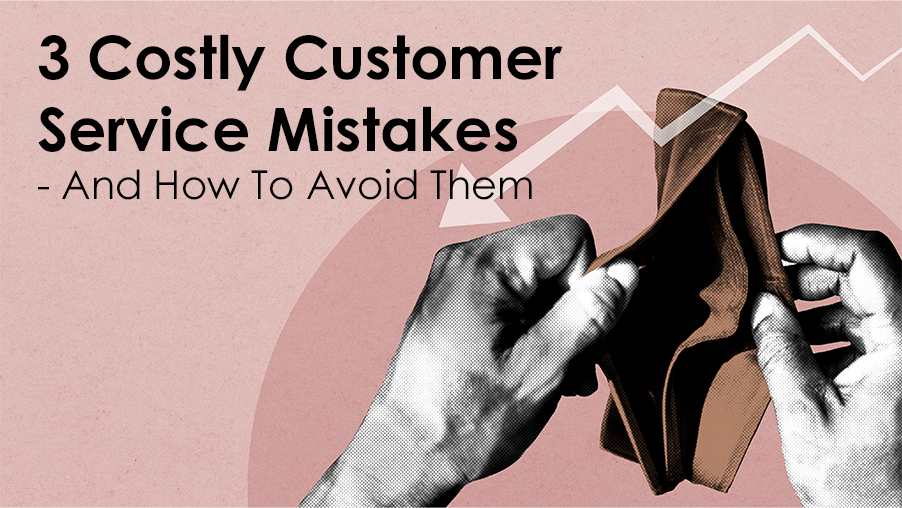-
Services
-
Locations
- Philippines
- United States
- Colombia
- Eastern Europe
Locations -
Industries
-
Resources
- E-Books
- Blog
- Case Studies
Resources - About Us
- Careers
Providing great customer service is critical for building a strong brand. One in three consumers in the U.S. would walk away from a brand they love after just one bad service experience, according to a recent PwC study. By contrast, 70% of consumers say they’re willing to spend more on companies that offer good customer service.
If bad service is so costly, why do companies keep messing up? Customer support is a people management game. Usually, companies that do it poorly have made one or more – of these three common mistakes: hiring the wrong customer service agents, failing to onboard them properly, and failing to actively measure and manage their performance. Here’s how to avoid these three costly mistakes.
Hiring Mistake: Hiring rule-followers, not critical thinkers
Ten or 20 years ago, people called customer service with simple questions. Today, they can get answers to most simple questions online, so they turn to your customer support team for complex queries, something they can’t find in the FAQs.
That means agents should be able to quickly grasp the complexity of the situation, analyze it and present possible solutions. Nothing is more annoying than when you get a template response that doesn’t address your actual question.
When hiring customer support agents, look for people who are able to think on their feet and make sound judgements. You can use the interview to gauge these abilities. For example, you can ask them to describe an instance when their work was criticized, and how they dealt with it. How would they deal with an upset customer? You can present a hypothetical situation and ask how they would resolve it.
In their responses, look out for things like how the candidate analyzes a situation, and weighs the pros and cons. Is the candidate able to strike a balance in making a good, yet fast decision? How does she handle difficult situations, or behave under pressure?
Training Mistake: Failing to properly onboard agents
It’s not enough to hire great talent. This talent can easily slip away if you don’t provide proper onboarding.
Onboarding is not just about training them on the task at hand; it’s about integrating them into the company’s culture. Employees who receive effective onboarding have higher morale and feel a stronger connection to their work. This isn’t important only for your high-level hires; it’s critical for your customer service representatives.
To avert this, put in place a robust formal training that includes sharing the company’s mission, vision, and core values – not just product knowledge. Enlist your experienced agents to work one-on-one with the new recruits, and to help them assimilate into the company.
At the end of your onboarding process, new support agents should be true advocates of your product and your brand. And of course, training should not be limited to new hires; it should done periodically, as a refresher, and to update staff as your business evolves.
Management Mistake: Judging performance based on opinion, not data
It is not uncommon for CEOs, especially of start-ups, to rely heavily on their gut feelings to make decisions – and that includes assessing the performance of employees.
But hard data on the performance of your customer service agents is readily available, and there’s no excuse not to use it. You may find that your customers actually have a different opinion than you do.
Begin by deciding the efficiency metrics that you want to measure. Some key ones are: first contact resolution, average wait time, average handle time, missed and/or abandoned calls and chats, first response time, full resolution time, and cases handled per hour.
Then, make sure you’ve turned on customer satisfaction (CSAT) surveys in your helpdesk platform, so you can assess customer satisfaction as well. If you’re only tracking productivity, agents will emphasize speed over quality in their responses.
Make sure you’re tracking these metrics weekly, if not daily. Review many – if not all – of your bad CSAT scores to identify opportunities for improvement. Simply measuring the data, communicating it to your team, and setting targets goes a long way toward improving performance. If your performance still isn’t meeting your standards, you can drill down into the data to figure out why. One of our clients American Exchange Group (iTouch) made sure to dive into their CSAT scores and had great success with their clients by tracking these metrics.
In short, it’s possible to build a solid customer service strategy if you invest the time to hire agents that have critical thinking skills, train them right, and rely on data analytics to measure their performance and the pulse of your customers.
If you want to know more about scaling customer support, you can download our e-book “Scaling Customer Support for Your Growing Business”.
Illustration by Rhea Avanceña


